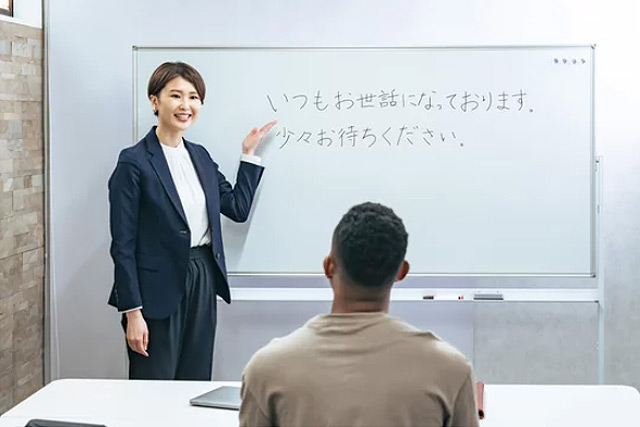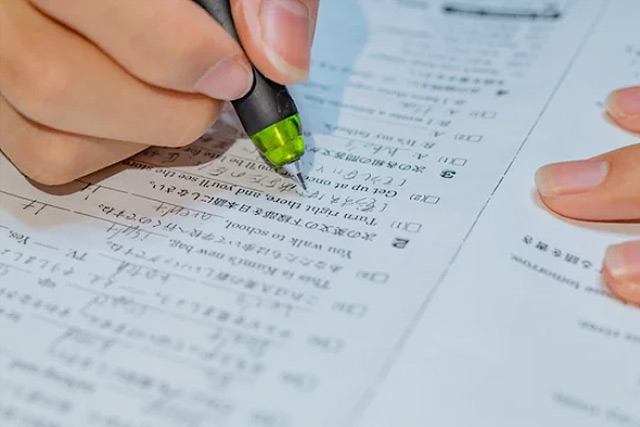- Learning Japanese
- Japanese Culture
Oku Sensei’s Guide to Japanese Grammar: The Essential Step-by-Step Roadmap for Japanese Learners
2025.06.19

A Clear Progression Plan for Mastering Japanese Grammar
How to Use This Guide
This is a roadmap, not a grammar textbook. It’s designed to show you what to study, and in what order, so you can build your grammar skills step-by-step without getting overwhelmed.
Japanese grammar is incredibly deep and nuanced—but trying to learn it randomly, or in the wrong sequence, often leads to confusion and burnout. Each level in this guide builds on the last, so it's important to master each layer before moving forward to the next.
After years of teaching students who felt lost or frustrated—bouncing from one app, textbook, or YouTube video to the next without any sense of direction—I realized I couldn't just stand by and watch learners drift aimlessly through the internet, unsure of which grammar points actually mattered or how to progress.
That’s why I created this roadmap: to guide learners clearly and calmly through the fog of Japanese grammar, with a structure that works in the real world.
Level 1: The Absolute Core of Japanese Grammar (Beginner)

Goal: Build a strong foundation in sentence structure and essential grammar rules.
1.1 Understanding Basic Sentence Structure (SOV)
- Japanese follows Subject-Object-Verb (SOV), unlike English (SVO).
- Fundamental particle: は (wa) → Topic marker
- Fundamental verb: です(desu)→ is/am/are
- 私は学生です。 (I am a student.)
- これは本です。 (This is a book.)
Essential demonstratives for objects (this, that, that over there):
- これ (kore) → This (near me) → これはペンです。 (This is a pen.)
- それ (sore) → That (near you) → それは時計です。 (That is a clock.)
- あれ (are) → That over there (far from both) → あれは山です。 (That over there is a mountain.)
Essential demonstratives for locations (here, there, over there):
- ここ (koko) → Here (near me) → ここは東京です。 (This is Tokyo.)
- そこ (soko) → There (near you) → そこは学校です。 (That is a school.)
- あそこ (asoko) → Over there (far from both) → あそこは駅です。 (That over there is a station.)
1.2 Learning Essential Particles
- Fundamental particles that define sentence roles:
- が (ga) → Subject marker
- を (wo) → Object marker
- に (ni) / で (de) → Time/location markers
- と (to) → "And" (for nouns) / "With" (for people & objects)
- か (ka) → Question marker (used at the end of a sentence to indicate a question)
Key point: In Japanese, once a topic is introduced with a topic marker, it carries for the rest of the conversation and does not need to be restated again. When the topic is a person in the conversation, the topic is most often omitted.
|
Particle |
Function |
Example Sentence |
|---|---|---|
|
は |
Topic |
私は学生です。(I am a student.) |
|
が |
Subject |
猫が好きです。(I like cats.) |
|
を |
Object |
映画を見ます。(I watch a movie.) |
|
に |
Destination / Time |
東京に行く。(Go to Tokyo.) |
|
で |
Place of action |
学校で勉強する。(Study at school.) |
|
と |
And / With |
友達と映画を見る。 (I watch a movie with my friend.) |
|
か |
Question marker |
彼は学生ですか(Is he a student?) |
- Example sentences:
- 家に帰る。 (Go home.)
- 名前をペンで書く (Write your name in pen.)
- ティムさんは図書館で友達と日本語を勉強します (Tim studies Japanese with his friend at the library).
1.3 Essential Verb Conjugations (Casual & Polite)
- Plain (casual) form vs. Polite form:
- 食べる (to eat) → 食べます (polite)
- 食べた (ate) → 食べました (polite)
- 食べない (don’t eat) → 食べません (polite)
- 食べなかった (didn’t eat) → 食べませんでした (polite)
1.4 Adjective Conjugation (Casual & Polite)
い-adjectives:
- Plain (casual) Form:
- 楽しい (fun) → 楽しくない (not fun)
- 楽しかった (was fun) → 楽しくなかった (was not fun)
- Polite Form:
- 楽しいです (It is fun) → 楽しくないです (It is not fun)
- 楽しかったです (It was fun) → 楽しくなかったです (It was not fun)
な-adjectives:
- Plain (casual) Form:
- きれい (beautiful) → きれいじゃない (not beautiful)
- きれいだった (was beautiful) → きれいじゃなかった (was not beautiful)
- Polite Form:
- きれいです (It is beautiful) → きれいじゃないです (It is not beautiful)
- きれいでした (It was beautiful) → きれいじゃなかったです (It was not beautiful)
1.5 Asking Basic Questions (Who, What, Where)
- 何? (What?)
- どこ? (Where?)
- 誰? (Who?)
- いつ? (When?)
- なぜ? / どうして? / なんで? (Why?)
- どう? / どうやって? (How?)
|
Japanese |
English |
Example Sentence |
Translation |
|---|---|---|---|
|
何 (なに) |
What? |
何を食べますか? |
What will you eat? |
|
どこ |
Where? |
どこに行きますか? |
Where are you going? |
|
誰 (だれ) |
Who? |
誰が来ますか? |
Who is coming? |
|
いつ |
When? |
いつ日本に行きますか? |
When are you going to Japan? |
|
なぜ / どうして / なんで |
Why? |
なぜ遅れましたか? |
Why were you late? |
|
どう / どうやって |
How? |
どうやって日本語を勉強しますか? |
How do you study Japanese? |
- Example sentences:
- 何を食べますか? (What will you eat?)
- どこに行きますか? (Where are you going?)
- 誰と一緒に勉強しますか?(Who will you study with?)
End of Level 1: The learner can now form basic sentences, ask questions, and use fundamental particles correctly.
Level 2: Expanding Functionality (Beginner-Intermediate)

Goal: Learn how to describe situations, express intentions, and give reasons.
2.1 Expressing State & Existence
- ~がある (for things) / ~がいる (for people & animals)
- ここに本がある。 (There is a book here.)
- 学校に先生がいる。 (There is a teacher at school.)
2.2 Connecting Actions (て-form & と)
How to Conjugate the て-form (for linking actions & commands):
|
Verb Type |
Rule |
Example (Base Form → て-form) |
|---|---|---|
|
る-verbs |
Drop る, add て |
食べる → 食べて (eat) |
|
う-verbs (ending in う, つ, る) |
Replace う/つ/る with って |
待つ → 待って (wait) |
|
う-verbs (ending in む, ぶ, ぬ) |
Replace む/ぶ/ぬ with んで |
読む → 読んで (read) |
|
う-verbs (ending in く) |
Replace く with いて |
書く → 書いて (write) |
|
う-verbs (ending in ぐ) |
Replace ぐ with いで |
泳ぐ → 泳いで (swim) |
|
う-verbs (ending in す) |
Replace す with して |
話す → 話して (speak) |
|
Irregular verbs |
Unique changes |
する → して (do), くる → きて (come) |
- ~て (used to link actions) & ~と (when/if this happens).
- 朝ご飯を食べて、学校に行く。 (Eat breakfast and go to school.)
- ボタンを押すと、ドアが開く。 (If you press the button, the door opens.)
2.3 Expressing Ability (Potential Form & ~ことができる)
- 泳ぐことができる。 (I can swim.)
- 日本語が話せる。 (I can speak Japanese.)
2.4 Expressing Wants
Wanting to Do Something (~たい)
- Used with verbs to express wanting to perform an action.
- Conjugation: Verb stem + たい (casual) / たいです (polite).
- 日本に行きたい。 → (I want to go to Japan.)
- 寿司を食べたいです。 → (I want to eat sushi.)
Key Point: たい is only used to describe your desires or when asking about someone else’s. It is only used for actions (verbs).
Wanting a Thing (ほしい)
- Used with nouns to express wanting a tangible object.
- Sentence structure: [Person] は [Object] がほしい
- 新しいパソコンがほしい。 → (I want a new computer.)
- お金がほしいです。 → (I want money.)
Key Point: ほしい is for things (nouns), not actions. To express wanting someone else to do something, use the ~て form of a verb with ほしい (e.g., 手伝ってほしい = "I want you to help me").
2.5 Expressing Giving & Receiving (くれる・もらう・あげる Verbs)
くれる is used when someone gives you something (they give to me).
もらう is used when something is received from someone (someone/I receive something).
あげる is used when I or someone else gives to another person. (me give to them OR someone gives to someone)
It is conjugated with the て-form of the verb + くれる / もらう / あげる :
- 手伝ってくれる? (Can you help me?)
- 日本語を教えてもらった。 (I was taught Japanese.)
|
Verb |
Meaning |
Example Sentence |
Who Benefits? |
|---|---|---|---|
|
Plain form: くれる ( Polite form: くださる ) |
Someone gives me (or my group) something |
母がプレゼントをくれた。 (My mom gave me a present.) |
I receive the benefit |
|
Plain form: もらう ( Polite form: いただく ) |
I receive something from someone |
友達からお土産をもらった。 (I received a souvenir from my friend.) |
I receive the benefit |
|
Plain form: あげる ( Polite form: 差し上げる ) |
I give something to someone |
友達に本をあげた。 (I gave my friend a book.) |
They receive the benefit |
2.6 Expressing Reasons (から & ので)
- ~から (because, informal) / ~ので (because, formal)
- お腹が空いたから、食べる。 (I’ll eat because I’m hungry.)
- 頭が痛いので、薬を飲みます。 (Since I have a headache, I’ll take medicine.)
2.7 Expressing Comparisons (より & ほうが)
- Comparing two things using より (than) & ほうが (preferred option).
- ラーメンより寿司のほうが好き。 (I like sushi more than ramen.)
End of Level 2: The learner can now express existence, wants, comparisons, and give reasons.
Level 3: Intermediate Communication

Goal: Learn how to express opinions, give suggestions, and describe hypothetical situations.
3.1 Making Requests & Asking for Permission
Asking for Permission: ~てもいいですか?
- Used to ask if an action is allowed or acceptable.
- Example sentences:
- トイレに行ってもいいですか? (May I go to the bathroom?)
- ここで写真を撮ってもいいですか? (Is it okay to take a picture here?)
📌 Use when checking if an action is permitted.
Making Direct Requests (Casual → Polite → Formal)
|
Level |
Expression |
Meaning |
Example Sentence |
Use Case |
|---|---|---|---|---|
|
Casual |
~てくれる? |
Can you? |
手伝ってくれる? (Can you help me?) |
Friends, family |
|
Casual |
~てくれない? |
Won't you? |
窓を閉めてくれない? (Won’t you close the window?) |
Slightly softer than ~てくれる |
|
Polite |
~てください |
Please do |
ドアを開けてください。 (Please open the door.) |
Standard polite speech |
|
Polite |
~てもらえますか? |
Can you do (for me)? |
写真を撮ってもらえますか? (Can you take a picture for me?) |
Public settings, coworkers |
|
Formal |
~ていただけますか? |
Could you do (for me)? |
説明していただけますか? (Could you explain?) |
Speaking to superiors, customers |
|
Very Formal |
~ていただけないでしょうか? |
Would it be possible for you to…? |
お時間をいただけないでしょうか? (Would it be possible to get some of your time?) |
Business, high-level formality |
Summary: When to Use Each Type of Request
|
Purpose |
Expression |
Example |
|---|---|---|
|
Asking for permission |
~てもいいですか? |
ここで食べてもいいですか? (May I eat here?) |
|
Asking for help casually |
~てくれる? / ~てくれない? |
宿題を手伝ってくれない? (Can you help me with my homework?) |
|
Making a polite request |
~てください |
静かにしてください。 (Please be quiet.) |
|
Politely asking someone to do something for you |
~てもらえますか? / ~ていただけますか? |
もう一度説明してもらえますか? (Can you explain that again?) |
|
Very formal request |
~ていただけないでしょうか? |
お名前を伺ってもよろしいでしょうか? (Would you kindly tell me your name?) |
3.2 Expressing Hypotheticals (~たら, ~ば, ~なら)
- 雨が降ったら、出かけない。 (If it rains, I won’t go out.)
- 安ければ、買う。 (If it’s cheap, I’ll buy it.)
- 静かなら、ここで勉強できる。 (If it’s quiet, I can study here.)
3.3 Expressing Opinions & probability (と思う, でしょう, かもしれない)
- 明日は雨が降ると思う。 (I think it will rain tomorrow.)
- 彼は忙しいでしょう。 (He’s probably busy.)
- 彼は来るかもしれない。 (He might come.)
3.4 Giving Suggestions (~たほうがいい)
- 早く寝たほうがいいよ。 (You should sleep early.)
- もっと日本語を勉強したほうがいい。 (You should study more Japanese.)
3.5 Expressing Obligation (~なければならない & ~なくてもいい)
- 宿題をしなければならない。 (I must do my homework.)
- 行かなくてもいい。 (I don’t have to go.)
End of Level 3: The learner can now express conditions, make requests, and state opinions.
Level 4: Advanced Communication (Upper Intermediate)

Goal: Speak naturally and fluently with keigo, uncertainty expressions, and nuanced phrases.
4.1 Using Keigo (Polite Speech)
- 先生がいらっしゃいます。 (The teacher is here.) → 私がお持ちします。 (I will bring it.)
4.2 Expressing Uncertainty & Contradictions
- ~かどうか (whether or not) / ~のに (despite, even though)
- 彼が来るかどうかわからない。 (I don’t know if he’s coming or not.)
End of Level 4: The learner has reached fluency in expressing nuanced thoughts and speaking politely.
Conclusion: The Road to True Japanese Mastery

This roadmap has provided you with a clear, structured path to learning fundamental Japanese grammar, ensuring you build a strong foundation step by step. However, this is just the beginning of your grammar journey.
Mastering Japanese grammar goes beyond fundamentals.
- This guide covers the core structures you need, but fluency requires immersing yourself in real-world usage, context, and nuance.
- To sound truly natural, you must learn more advanced sentence patterns, idiomatic expressions, and subtle grammar shifts that change depending on formality, tone, and situation.
- Grammar is not just a set of rules—it’s a tool that expresses culture, thought, and human connection in Japanese.
★Also try reading: The History and Fundamentals of Japanese Grammar
The next step: Deepening your knowledge through guided learning.
While this roadmap provides a strong foundation, moving into beginner-advanced, advanced, and master-level Japanese grammar study requires detailed instruction from an expert in both Japanese linguistics and education.
That’s where Oku Sensei’s guidance makes all the difference.
✔ Learn beyond just textbook definitions—understand when and how grammar is used naturally.
✔ Get tailored instruction that helps you break through common plateaus.
✔ Gain access to high-level grammar and nuanced expressions that will elevate your comprehension and fluency.
Ready to take your Japanese to the next level?
👉 Continue learning with OSJ’s structured courses for expert-led instruction.
👉 Join a class with Oku Sensei to receive personalized feedback and practice real-world grammar usage.
Final Message: This roadmap guides you through the fundamentals, but true mastery comes from consistent study, deepening your grammar knowledge, and learning from an experienced mentor. With the right structure, expert guidance, and dedication, your Japanese skills can reach heights you never imagined.


















